What Is Rhinoplasty ?
Rhinoplasty or nose surgery, nose job or nose reshaping, is an operation of cosmetic surgery whose purpose is to reshape the size, shape, tip of the nose or nostrils (nose resection). This will correct an unsightly nose, such as remove a lump on the back of the nose, a nose falling or too wide (rhinoplasty ethnic).
Moreover, this aesthetic intervention can be combined with a correction of a deviated nasal septum in order to improve the respiratory function.
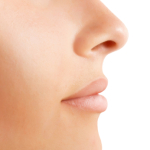
In addition to the aesthetic and physical function, the correction of an imperfection in the nose can be psychological, strengthen confidence and self-esteem. The nose being the center of the face, this intervention will harmonize the face and contribute to improve the well-being of the candidate.
Rhinoplasty and other interventions
A rhinoplasty can be performed alone or with another intervention of cosmetic surgery or aesthetic medicine. A chin surgery to improve the harmony of the face and the proportions, will be accompanied by a nose job. The combination of these two interventions is called profiloplasty.
Rhinoplasty in Hungary, Budapest
Internationally renowned surgeons
Private clinics accredited internationally
English assistance throughout your treatment
More than 80% savings on UK prices
Rhinoplasty Cost
The price of rhinoplasty in Hungary costs approximatively 3’000 euros. It includes the estimate, the consultation, the preoperative tests (medical examination, blood test, electrocardiogram), the general anesthesia, the intervention, the hospitalization of 1 night in the clinic and a post-operative control before your departure in UK . In addition, this price includes personal assistance in English throughout the stay and transfers between the airport and the clinic. Finally, regarding the stay, we offer a 4 star accommodation a minute walk from the clinic and at a preferential price.
You can find more information in our price list.
Different Types of Rhinoplasty
Primary Rhinoplasty
Primary rhinoplasty is a reconstructive and a cosmetic surgery. This can reduce or increase the size of the nose, change the shape of the nose, correct the tip of the nose, remove a lump on the nose, repair a broken nose, correct a deviation of the nasal septum or improve the angle between the nose and the upper lip.
Secondary Rhinoplasty
Secondary rhinoplasty is a second nose job aimed at improving or correcting the unsatisfactory and unintended results of a first “missed rhinoplasty”. This is more complex and it is necessary to wait for a sufficient period of healing between the two interventions, ie at least 12 months.
Ethnic Rhinoplasty
Ethnic rhinoplasty aims to improve the typical features of Asian or African noses. It is a more complex nose surgery and may require multiple intervention. Often, it is necessary to refine a nose too wide, to correct a stop of the nose too low, to improve the projection of a flat nose and to reduce the size of the nostrils.
Nostril Reduction
The nostril reduction or alarplasty, consists of reducing the size of the nostrils. Nasal resection is the procedure to reduce the size of the nostrils and the alar base. The surgical technique will depend on the shape of the nostrils and the size of the nostrils.
Rhinoplasty Candidate
The candidate for a rhinoplasty is someone who wants to improve the aesthetics of his nose, correct a deviation of his nasal septum, improve his respiratory function or rebuild his nose following an accident or following a malformation. There is no ideal age for this surgery, however it is necessary to wait until the nose has finished its development. In general, the candidate must be in good health, ideally non-smoker and have realistic expectations of the results of the intervention.
Preparing for Rhinoplasty Surgery
Rhinoplasty requires preparation on the part of the candidate.
1 month before the procedure, it will be necessary to stop smoking. The smoke increases the risk of operating complications.
2 weeks before surgery, do not take any medicine containing aspirin. This increases the risk of bleeding. In addition, you will need to take food supplements and vitamins. The patient will also need to adjust his current medications.
1 day before the operation, pre-operative tests and a medical check-up will be carried out at the clinic.
Finally, the day of the surgery, it will be necessary to present fasting to the clinic.
Rhinoplasty Procedure Steps
Stay
A stay of one week on the spot is necessary.
Anesthesia
Rhinoplasty is performed under general anesthesia.
Duration of the Procedure
A nose surgery lasts between 60 and 90 minutes.
Incisions
Today, the incisions are made at the level of the columella. This is the space between the two nostrils. Additional incisions can also be made inside the narrators. This is called open technique or open rhinoplasty.
The other technique is called closed rhinoplasty. Incisions are made inside the nose. It should be noted that this technique is currently less frequent. Indeed, it is less accurate than open nose surgery and gives less symmetrical results.
Hospitalization
Overnight hospitalization is required after nose surgery. In rare cases, if the procedure is performed under local anesthesia, the patient can return home the same day.
Rhinoplasty Recovery
For a quick recovery, the surgeon will indicate the indications to follow.
A period of desocialization of 2 weeks is expected before returning to work.
After surgery and when anesthesia dissipates – tense and painful nose may appear. Headaches can also be felt. The surgeon will prescribe medications to manage these discomforts.
The first night, you will have to sleep with your head elevated.
Swelling of the nose and bruising around the nose first appear, peaking after two to three days. Most swelling and bruising should disappear within two weeks at the latest. You can apply cold compresses to reduce them.
Some bleeding is common for a few days after the operation, and you may continue to experience some congestion for a few weeks.
Generally, a cast, stitches and tampons are put in place after the surgery. The surgeon will remove them 1 week after surgery and before you return to United Kingdom.
Regarding physical activities, it will be necessary to stop them during the month following the rhinoplasty.
During the healing period of the tissues, it is recommended not to blow your nose for a week or two. Only the surgeon is able to evaluate these delays.
It is advisable to avoid any alcohol consumption during the healing period, as this can lead to increased water retention and longer recovery times.
Rhinoplasty Results
Rhinoplasty provides remarkable results, especially in the cases of flat nose, lump on the nose and large nostrils. The right proportions between the nose and the faces are restored.
Results are appreciable after 3 months, the time that swelling and bruising disappear. The final result will be judgeable within 6 to 12 months after the nose surgery.
Rhinoplasty Before and After Pictures


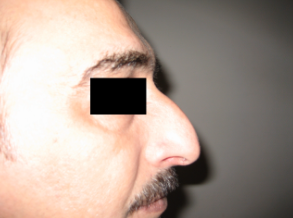
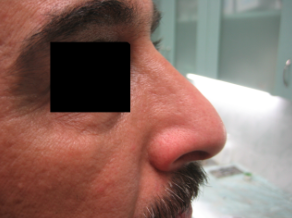
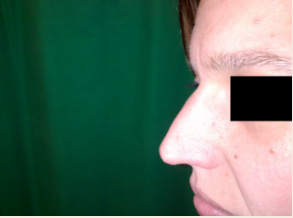
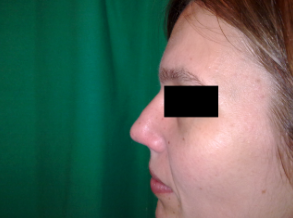
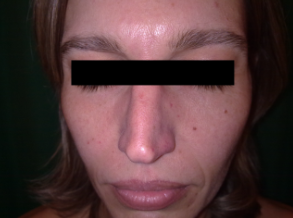
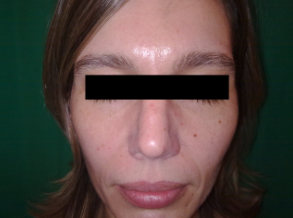
Rhinoplasty Risks and Complications
When rhinoplasty is performed properly, complications are usually rare and benign.
However, each surgery involves risks and complications. Carefully following your surgeon’s recommendations before and after the operation will help reduce them. Specific risks and precautions differ from one individual to another and will be determined at the time of consultation.
At the level of the surgery, there are the risks of the anesthesia, a result different from the expected result or a perforation of the nasal septum.
Immediate risks include bleeding, inflammation, swelling, hematoma and bruising.
Nasal obstruction and breathing difficulties are also possible.
Then, a loss of sensitivity in the nose may persist for a few weeks.
Finally, there is a risk of poor healing or a longer healing time.
Rhinoplasty Testimonials
I always wanted to be a model, as I’m tall and thin; the only problem was the shape of my nose. Now I finally managed to get modeling contracts thanks to my rhinoplasty in Hungary. I am a student, hence I could not have afforded the surgery in the UK. Plus I do not think the result could have been better.
The price of a rhinoplasty in Budapest with SwissMedFlight is 3x cheaper than what a UK surgeon would have charged me in Geneva. I am really happy with the result. The staff is very friendly and supportive throughout the whole medical stay in Hungary.
